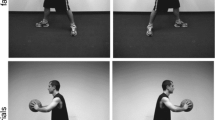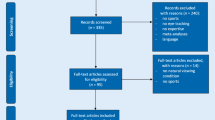Abstract
Reactions to the pass of a basketball player performing a head fake are typically slower than reactions to a basketball player who passes without a head fake (i.e., head-fake effect). The present study shows that extensive practice reduces the head-fake effect in basketball. Additional analyses were conducted to explore the mechanism behind the reduced head-fake effect. First, we analyzed whether or not participants developed some control over the processing of irrelevant gaze direction, as indicated by specific trial-to-trial adaptations (i.e., congruency sequence effect). Second, we fitted the individual frequency distributions of RTs to ex-Gaussian distributions, to evaluate if practice specifically affects the Gaussian part of the distribution or the exponential part of the distribution. Third, we modeled individual RT distributions as the so-called mixture effects to examine whether the way irrelevant gaze direction impacts performance (either occasionally but massively or continuously but moderately) changes with practice. The analyses revealed that the effect of practice could not be explained with an increasing congruency-sequence effect. Also, it could not be found in the ex-Gaussian distributional analyses. The assumption that residual failure to inhibit the processing of the gaze direction in contrast to continuous failures to do so might favor mixed effects over uniform effects at later courses of practice could not be validated. The reduced head-fake effect thus is argued to source in participants’ general increasing ability to inhibit the processing of the task-irrelevant gaze direction information and/or in a priority shift of gaze processing to a processing of the pass direction.






Similar content being viewed by others
Notes
The term head fake both includes the passing movement to one side and the simultaneous head movement to the contrary side. The phrase “responding to a head fake” here and in the following manuscript means “responding to the pass in the presence of a head fake”.
CIPD = confidence interval for paired differences (cf. Pfister & Janczyk, 2013).
References
Adams, J. A. (1971). A closed-loop theory of motor learning. Journal of Motor Behavior, 3(2), 111–149.
Alhaj Ahmad Alaboud, M., Güldenpenning, I., Steggemann-Weinrich, Y., Kunde, W., & Weigelt, M. (2016). Täuschungshandlungen im Sport: Der Blicktäuschungseffekt im Basketball unter quasirealistischen Bedingungen. Sportwissenschaft, 46(3), 223–231.
Alhaj Ahmad Alaboud, M., Steggemann, Y., Klein-Soetebier, T., Kunde, W., & Weigelt, M. (2012). Täuschungshandlungen im Sport: Eine experimentelle Untersuchung zur Wirkung der Häufigkeitsverteilung auf die Blicktäuschung im Basketball. Zeitschrift für Sportpsychologie, 19(3), 110–121.
Appelbaum, L. G., & Erickson, G. (2016). Sports vision training: A review of the state-of-the-art in digital training techniques. International Review of Sport and Exercise Psychology. https://doi.org/10.1080/1750984X.2016.1266376.
Balota, D. A., & Yap, M. J. (2011). Moving beyond the mean in studies of mental chronometry: The power of response time distributional analyses. Current Directions in Psychological Science, 20(3), 160–166.
Compton, B. J., & Logan, G. D. (1991). The transition from algorithm to retrieval in memory-based theories of automaticity. Memory & Cognition, 19(2), 151–158.
Davidson, D. J., Zacks, R. T., & Williams, C. C. (2003). Stroop interference, practice, and aging. Aging, Neuropsychology, and Cognition, 10(2), 85–98.
Dulaney, C. L., & Rogers, W. A. (1994). Mechanisms underlying reduction in Stroop interference with practice for young and old adults. Journal of Experimental Psychology: Learning, Memory, and Cognition, 20(2), 470.
Ellis, N. R., Woodley-Zanthos, P., Dulaney, C. L., & Palmer, R. L. (1989). Automatic effortful processing and cognitive inertia in persons with mental retardation. American Journal on Mental Retardation, 93, 412–423.
Gratton, G., Coles, M. G. H., & Donchin, E. (1992). Optimizing the use of information: Strategic control of activation of responses. Journal of Experimental Psychology: General, 121(4), 480–506.
Güldenpenning, I., Alhaj Ahmad Alaboud, M., Kunde, W., & Weigelt, M. (2018). The impact of global and local context information on the processing of deceptive actions in game sports: Both higher head-fake frequencies and head-fake repetitions reduce the size of the head-fake effect in basketball. German Journal of Exercise and Sport Research. https://doi.org/10.1007/s12662-018-0493-4.
Güldenpenning, I., Kunde, W., & Weigelt, M. (2017). How to trick your opponent: A review article on deceptive actions in interactive sports. Frontiers in Psychology. 8, 917
Heathcote, A., Popiel, S. J., & Mewhort, D. J. (1991). Analysis of response time distributions: An example using the Stroop task. Psychological Bulletin, 109(2), 340.
Kunde, W., Skirde, S., & Weigelt, M. (2011). Trust my face: Cognitive factors of head fakes in sports. Journal of Experimental Psychology: Applied, 17(2), 110–127. https://doi.org/10.1037/A0023756.
Lacouture, Y., & Cousineau, D. (2008). How to use MATLAB to fit the ex-Gaussian and other probability functions to a distribution of response times. Tutorials in Quantitative Methods for Psychology, 4(1), 35–45.
Langton, S. R. H., Watt, R. J., & Bruce, V. (2000). Do the eyes have it? Cues to the direction of social attention. Trends in Cognitive Sciences, 4(2), 50–59.
Luce, R. D. (1986). Response times: Their role in inferring elementary mental organization. New York: Oxford University Press.
MacLeod, C. M. (1991). Half a century of research on the Stroop effect: An integrative review. Psychological Bulletin, 109(2), 163–203. https://doi.org/10.1037/0033-2909.109.2.163.
MacLeod, C. M. (1998). Training on integrated versus separated Stroop tasks: The progression of interference and facilitation. Memory & Cognition, 26(2), 201–211.
Miller, J. (2006). A likelihood ratio test for mixture effects. Behavior Research Methods, 38(1), 92–106. https://doi.org/10.3758/BF03192754.
Osman, A., Lou, L., Muller-Gethmann, H., Rinkenauer, G., Mattes, S., & Ulrich, R. (2000). Mechanisms of speed–accuracy tradeoff: Evidence from covert motor processes. Biological Psychology, 51(2), 173–199.
Pfister, R., & Janczyk, M. (2013). Confidence intervals for two sample means: Calculation, interpretation, and a few simple rules. Advances in Cognitive Psychology, 9(2), 74–80.
Prinz, W. (1997). Perception and action planning. European Journal of Cognitive Psychology, 9(2), 129–154.
Raftery, A. E. (1995). Bayesian model selection in social research. Sociological Methodology, 25, 111–163.
Reynolds, A., & Miller, J. (2009). Display size effects in visual search: Analyses of reaction time distributions as mixtures. Quarterly Journal of Experimental Psychology, 62(5), 988–1009.
Spieler, D. H., Balota, D. A., & Faust, M. E. (1996). Stroop performance in healthy younger and older adults and in individuals with dementia of the Alzheimer’s type. Journal of Experimental Psychology: Human Perception and Performance, 22(2), 461.
Strobach, T., Salminen, T., Karbach, J., & Schubert, T. (2014). Practice-related optimization and transfer of executive functions: A general review and a specific realization of their mechanisms in dual tasks. Psychological Research Psychologische Forschung, 78(6), 836–851.
Stroop, J. R. (1935). Studies of interference in serial verbal reactions. Journal of Experimental Psychology, 18(6), 643–662. https://doi.org/10.1037/h0054651.
Weigelt, M., Güldenpenning, I., Steggemann-Weinrich, Y., Alhaj Ahmad Alaboud, M., & Kunde, W. (2017). Control over the processing of the opponent’s gaze direction in basketball experts. Psychonomic Bulletin & Review, 24(3), 828.
Whelan, R. (2008). Effective analysis of reaction time data. Psychological Record, 58(3), 475–482.
Wilkinson, A. J., & Yang, L. (2012). Plasticity of inhibition in older adults: Retest practice and transfer effects. Psychology and Aging, 27(3), 606.
Funding
This work was supported by the German Research Foundation (DFG) under Grant (GU 1683/1–1, KU 1964/ 13–1).
Author information
Authors and Affiliations
Corresponding author
Ethics declarations
Conflict of interest
All the authors declare that they have no conflict of interest.
Ethical approval
The study was conducted in accordance with the German Psychological Society (DGPs) ethical guidelines (2004, CIII). This research was also reviewed and approved by the German Research Council [DFG, project number (GU 1683/1–1)], which did not require Institutional Review Board approval. All procedures performed in the study were in accordance with the 1964 Helsinki Declaration and its later amendments.
Informed consent
Written informed consents (which were signed by the participants) informed the participants that their data will be anonymously (i.e., without access to their names) saved, analyzed, and published.
Rights and permissions
About this article
Cite this article
Güldenpenning, I., Schütz, C., Weigelt, M. et al. Is the head-fake effect in basketball robust against practice? Analyses of trial-by-trial adaptations, frequency distributions, and mixture effects to evaluate effects of practice. Psychological Research 84, 823–833 (2020). https://doi.org/10.1007/s00426-018-1078-4
Received:
Accepted:
Published:
Issue Date:
DOI: https://doi.org/10.1007/s00426-018-1078-4




